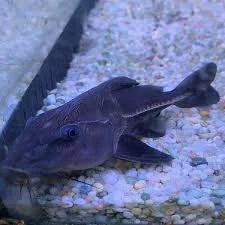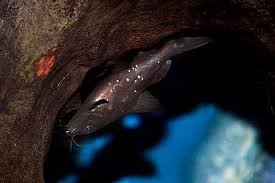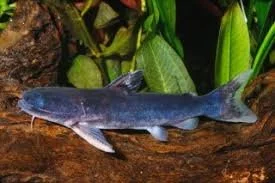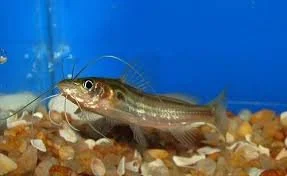 Image 1 of 1
Image 1 of 1


Catfish - Sailfin Pim XLarge
The Sailfin Pim (*Leiarius pictus), also known as the Painted Catfish or Marbled Pim, is a large, predatory freshwater fish from South American river basins. It is known for its beautiful, marbled or spotted pattern and a large, distinctive "sail-like" dorsal fin. As an adult, it can reach up to 24 inches (60 cm) and requires a very large aquarium or pond.
Physical description
Size: Can grow to 24 inches (60 cm) or more.
Color: Dark brown body with darker spots and a lighter underside.
Markings: Juvenile specimens have two parallel, pale bands running down the body. The large dorsal, adipose, and caudal fins have large spots, while the anal and ventral fins have smaller spots.
Fins: Features a large, prominent, "sail-like" dorsal fin, which is especially noticeable in younger fish.
Barbels: Has very long barbels, particularly in juveniles.
Habitat and care
Origin: Native to the Amazon and Orinoco river basins in South America.
Temperament: Predatory and can be territorial. It will eat any fish that is small enough to fit in its mouth.
Compatibility: Best kept with other large fish, like Oscars, and should not be housed with other Pimelodidae species.
Aquarium: Requires a very large aquarium or tropical pond to accommodate its adult size. A fine sand substrate is recommended, or no substrate at all to simplify cleaning.
Diet: A primarily carnivorous diet of meaty foods such as prawns, earthworms, crustaceans, silversides, and sinking pellets.
Other facts
Disease: Generally hardy but susceptible to common fish diseases like Ich, fin rot, and bacterial infections.
Spines: Has sharp spines on its dorsal and pectoral fins, so care should be taken when handling.
Breeding: Breeding has not been recorded in the aquarium hobby due to the massive tank size required.
The Sailfin Pim (*Leiarius pictus), also known as the Painted Catfish or Marbled Pim, is a large, predatory freshwater fish from South American river basins. It is known for its beautiful, marbled or spotted pattern and a large, distinctive "sail-like" dorsal fin. As an adult, it can reach up to 24 inches (60 cm) and requires a very large aquarium or pond.
Physical description
Size: Can grow to 24 inches (60 cm) or more.
Color: Dark brown body with darker spots and a lighter underside.
Markings: Juvenile specimens have two parallel, pale bands running down the body. The large dorsal, adipose, and caudal fins have large spots, while the anal and ventral fins have smaller spots.
Fins: Features a large, prominent, "sail-like" dorsal fin, which is especially noticeable in younger fish.
Barbels: Has very long barbels, particularly in juveniles.
Habitat and care
Origin: Native to the Amazon and Orinoco river basins in South America.
Temperament: Predatory and can be territorial. It will eat any fish that is small enough to fit in its mouth.
Compatibility: Best kept with other large fish, like Oscars, and should not be housed with other Pimelodidae species.
Aquarium: Requires a very large aquarium or tropical pond to accommodate its adult size. A fine sand substrate is recommended, or no substrate at all to simplify cleaning.
Diet: A primarily carnivorous diet of meaty foods such as prawns, earthworms, crustaceans, silversides, and sinking pellets.
Other facts
Disease: Generally hardy but susceptible to common fish diseases like Ich, fin rot, and bacterial infections.
Spines: Has sharp spines on its dorsal and pectoral fins, so care should be taken when handling.
Breeding: Breeding has not been recorded in the aquarium hobby due to the massive tank size required.






